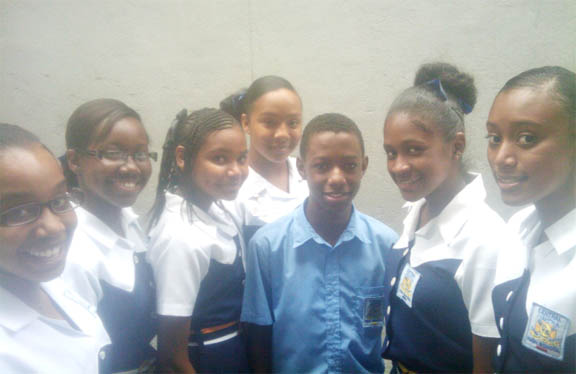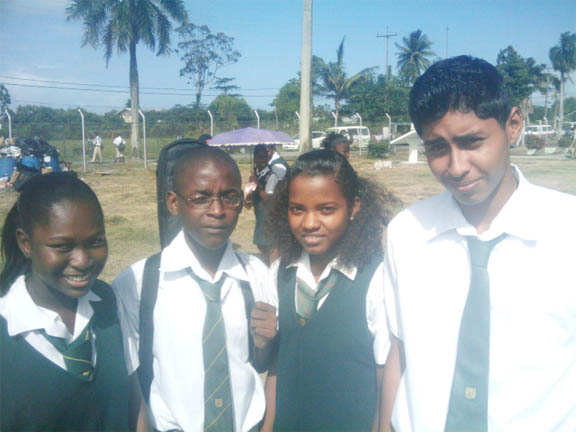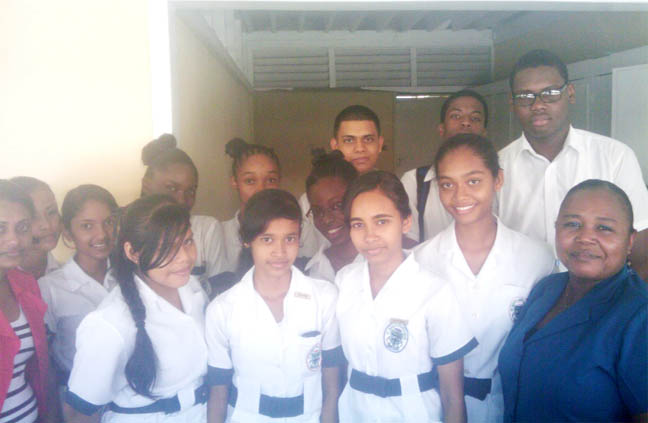One day before the February 16 deadline, students from several schools across Guyana are busy putting the finishing touches to their Project Description Proposals as they attempt to edge each other out to become the national winner of this year’s Sagicor Visionaries Challenge for Secondary Schools.
Yesterday, Central High School third formers took advantage of their school’s 12:00 pm dismissal to work feverishly on the finishing touches of their group’s proposal. Thirteen-year-old Savannah Pearson, although not the group’s designated leader, wasted no time in explaining her group’s project and its intended purpose.

The third formers, who are all hoping to enter the Science stream come September, chose to focus on redesigning and general improvement of their school’s science laboratory. The students said that the facilities and equipment in the laboratory left much to be desired and were in need of redoing.
Pearson explained that they intended to accomplish this task by recycling plastic bottles and selling them to raise funds. She said that when her group examined the practices of other schools, they realised that bottles were ultimately being discarded. She said her group decided to capitalise on this by selling the bottles to a local company.
Terief McPherson, the group’s designated leader, stated that this will not only enable them to preserve the environment, but also to raise the requisite funds needed to carry out the much needed improvement of the school’s laboratory facilities and equipment.
So far the students have placed several outlets around the school where other student and even teachers can place their unwanted plastic bottles for later retrieval. In terms of revamping the lab, McPherson said questionnaires were handed out to their fellow students so as to give them an opportunity to suggest improvements that should be made.

Groups from St Rose’s High were also in high spirits over their proposals. It should be noted that of all the schools indicating their intention to submit proposals, St Rose’s is leading with four separate proposals. Stabroek News met representatives of the school’s four groups, who indicated that each of their projects is aimed at reducing global warming and improving the school’s surroundings. Anastacia James, 15, who is working with all four groups, said that their prime objective is to improve their labs, art rooms, washrooms, and the general school environment. She said the first project includes efforts to curb land, water and air pollution as well as engage in beautification projects all around the school.
Another student shared that the second project concerns the provision of clean drinking water to staff and students since the current arrangements leave much to be desired. James further explained that the fourth project will deal with improving the ventilation of classrooms and other rooms around the school. This point was emphasized by several other individuals who stated that poor ventilation, especially in classrooms, had several spin-off effects, which negatively impact their ability to learn to some extent and affected their teachers’ ability to carry out their responsibilities efficiently.
Students from the Richard Ishmael Secondary School are convinced that their project is unique, and with good reason. Group leader for the fourth form team, Alisa Harry, explained that the project proposal was based on improving numeracy and literacy in the school. Harry shared that several individuals who come into the school often have difficulty reading and writing, which must be addressed.

As such the team intends to use solid waste from around their school to make teaching aids to help these individuals. She said Popsicle sticks, empty juice cans, straws, and even bottle caps will be recycled to make teaching aids to help students who have literacy and numeracy issues. She also explained their intention to use music as an aid as well. Harry shared intentions to incorporate elements of the school curriculum into songs to help convey the various lessons. Harry said music is something everyone, especially young people, can relate easily to and expressed optimism that this method will be successful.
According to Dr Maya Trotz, Associate Professor of Environmental Engineering at the University of South Florida, the challenge is the product of a partnership between Sagicor, the Caribbean Science Foundation, and the Caribbean Examination Council and it aims to: boost institutional capacity in Science Technology and Engineering and Mathematics (STEM) in secondary schools in the Caribbean, ignite interest among youth for innovation in STEM in an effort to build and integrate sustainable communities throughout the Caribbean; and integrate knowledge gained from formal and informal education to enable tomorrow’s leaders to build a more sustainable Caribbean.
Vying for the top spot in Guyana’s case are Queen’s College, West Demerara Secondary, Anna Regina Multilateral, Central High, Corentyne Comprehensive, St Rose’s High, Richard Ishmael, Annandale Secondary, Diamond Secondary, Tutorial High School and several others.
It should be noted that each of the three schools interviewed, along with the others mentioned have applied for, and have been assigned mentors. Each mentor is deemed to be a professional in his/her field and is expected to give guidance to the groups on modelling of their projects.
Between February 17 and February 22 the projects will be made available online for the public to vote on and students are encouraged to tell everyone they know to visit the website and support their projects since this becomes a percentage of their judging criteria.
From February 23 to March 23, national competitions will be held in the various countries. There, the competing students will be provided with poster boards, tables and power outlets that they can use in any way to showcase their project idea and convince the competition’s judges that their projects are the best. The team leader from each winning team and supervising teacher at the national level will compete in the regional competition in Barbados on April 12 and 13. They will also represent their respective country in a seven-day STEM Ambassador programme in Florida, USA which includes visits to places like the Kennedy Space Center, Disney’s EPCOT center, the Museum of Science and Industry and the engineering labs at the University of South Florida.





